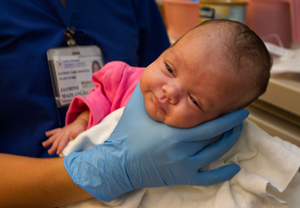A very special small package: Three-pound baby receives pacemaker
A very special small package: Three-pound baby receives pacemaker
My colleague Erin Digitale tells the remarkable story today of a tiny Lucile Packard Children’s Hospital heart patient named Jaya Maharaj. Weighing just 3.5 pounds, with a heart slightly bigger than a walnut, the baby received a pacemaker shortly after birth and was “smaller than any pacemaker recipient ever reported in the medical literature.”

Digitale writes in Inside Stanford Medicine:
Jaya’s surgery is remarkable not just because of her small size but because many fetuses with her condition, congenital heart block, do not survive pregnancy. Research has shown that 20 to 50 percent of patients diagnosed prenatally die in utero or in the first weeks after birth. Yet premature delivery to implant a pacemaker carries its own hazards. When Leanne Maharaj, Jaya’s mom, was first referred to Packard Children’s Hospital from her hometown of Hayward, Calif., at 28 weeks pregnant, her doctors weighed the conflicting risks.
“We knew that at any time the baby’s heart could give out,” said neonatologist Valerie Chock, MD, a member of the large, multidisciplinary team that planned Jaya’s birth and surgery. “We had to decide: At what point do we deliver to balance that risk against the risk of premature delivery?”
The baby was ultimately delivered nine weeks early and went into surgery just 15 minutes after being born. And then:
After surgery, Jaya spent six weeks in the Neonatal Intensive Care Unit. With her heart pumping properly, she grew rapidly and was able to go home on Jan. 12. Her prognosis is excellent: Her pacemaker leads must be repositioned occasionally as she grows, and she will need new pacemaker batteries every five to seven years, but otherwise she will be able to lead a normal life.
By Michelle Brandt
Stanford University Medical Center
Photo by Norbert von der Groeben
###
* Stanford University Medical Center integrates research, medical education and patient care at its three institutions – Stanford University School of Medicine, Stanford Hospital & Clinics and Lucile Packard Children’s Hospital.
** The above story is adapted from materials provided by Stanford University School of Medicine
________________________________________________________________




















